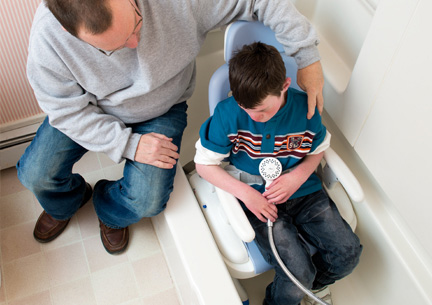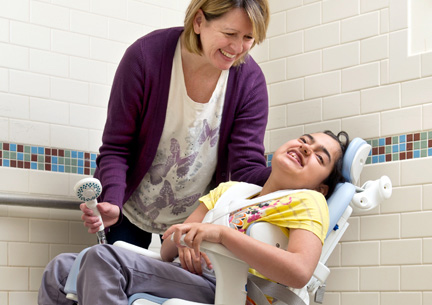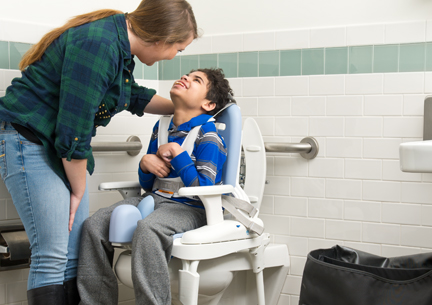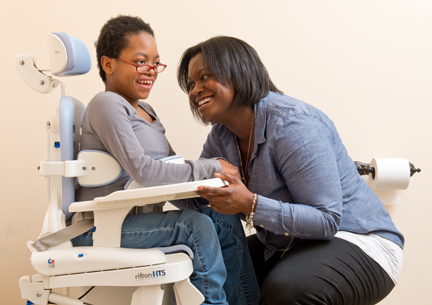Function-based Practice: The Rifton Support Station
| April 2012As an Occupational Therapist I view toileting as a functional life skill, not as an interruption to the day. The product that makes this possible is the Rifton Support Station.
For each of the more than twenty students on my caseload I incorporate a toileting objective on their IEP. And for those students using the Support Station, I will work with them once a day for their toileting routine.
I never place our students in a horizontal position on a changing table for hygiene care. It is demeaning to the children, especially the older ones, having them lie on a changing table like a baby. So I provide hygiene care for my students by leaning them forward on a padded table. Getting the students to hold on while leaning up against this table was very challenging. That’s why the Support Station is revolutionary.
 The Support Station is adaptable: It adjusts to accommodate different student heights. The trunk board can be angled for different weight bearing abilities. And the swivel is helpful; once a child is leaning against it, it assists in the transfer to a toilet, depending how you have positioned the Support Station in the bathroom.
The Support Station is adaptable: It adjusts to accommodate different student heights. The trunk board can be angled for different weight bearing abilities. And the swivel is helpful; once a child is leaning against it, it assists in the transfer to a toilet, depending how you have positioned the Support Station in the bathroom.
The shape of the trunk board allows comfortable placement of the student’s arms. There is also the option of handholds allowing the child to assist in the transfer. The support strap is useful in safely securing the child while their lower extremities and clothing adjustments are managed.
I use the Support Station for any student age 10 or older who has limited to almost no weight bearing. Many have cerebral palsy or other diagnoses where they are in a wheelchair and have spasticity or fluctuating muscle tone. With the Support Station, they can get in and out of their wheelchairs easily. I even do it with students that are tube-fed.
With the Support Station we are seeing increased functional participation for students who are large and with limited weight bearing. By practicing toilet transfers with the Support Station our students no longer remain in their wheelchairs all day and they grow stronger. This regular practice carries over into improvements in walking or sitting. So that’s why we look at toileting as an opportunity and not an  interruption.
interruption.
Additionally, with the Support Station, we are seeing improved continence. One of my students, Angelica, uses the Support Station as an adaptive toileting aid. It allows her to use the toilet regularly after lunch and “accidents” have been noticeably decreased – a real success story. So I believe that with the right tools, training students to toileting regularity is possible with dedicated time and effort. Consistency is the key.
 When our adolescent students transition into adulthood, perhaps two of the biggest barriers to increased participation in society are difficulty with transfers and toileting. The Support Station addresses both of these, not only as an aid that makes each toileting episode easier, but also as a tool for the possibility of improving sit-to-stand strength and even training toileting continence with consistency and regularity.
When our adolescent students transition into adulthood, perhaps two of the biggest barriers to increased participation in society are difficulty with transfers and toileting. The Support Station addresses both of these, not only as an aid that makes each toileting episode easier, but also as a tool for the possibility of improving sit-to-stand strength and even training toileting continence with consistency and regularity.
I would like to see Support Stations placed in all adult centers to facilitate our students as they graduate beyond the school setting. It’s truly a life-changing product.
The William S Baer School was one of the early adopters of the MOVE Program.




